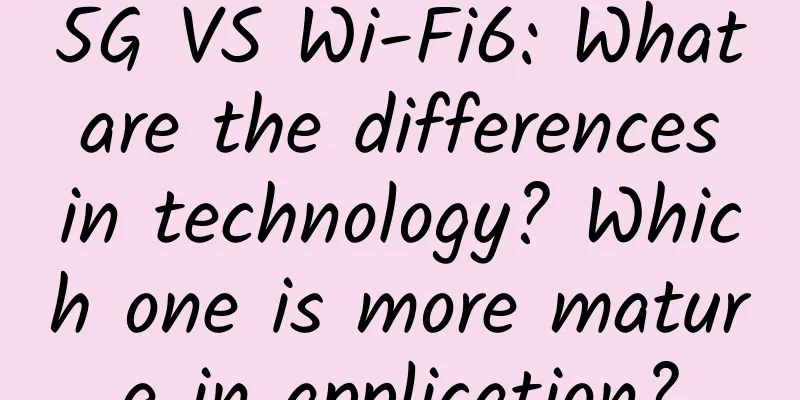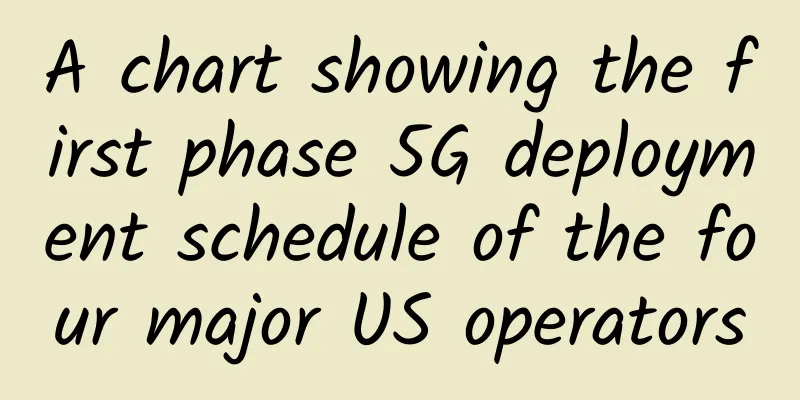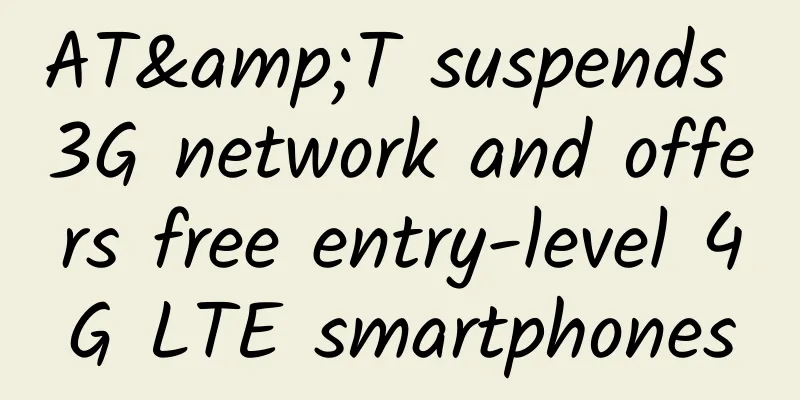5G VS Wi-Fi6: What are the differences in technology? Which one is more mature in application?

|
5G is the abbreviation for the fifth generation of mobile cellular network technology. It is a new generation of broadband mobile communication technology with the characteristics of high speed, low latency and large connection. It is the network infrastructure for realizing the interconnection between people, machines and things. Core technologies of 5GThe core technologies of 5G mainly include millimeter wave (short wavelength, high frequency band, and unable to bypass obstacles), small base stations (due to wavelength limitations, small base stations avoid signals from penetrating walls), massive MIMO (multiple antennas provide a variety of content services to ensure high speeds), beamforming (directional output to avoid interference), and full-duplex (simultaneous uplink and download services are possible). Traffic costs5G uses licensed frequency bands. Mobile operators need to purchase and use these spectra and deploy enough base stations to cover more users. Therefore, if 5G technology is to replace Wi-Fi, operators need to launch unlimited data packages, which will be more expensive. In contrast, Wi-Fi uses unlicensed wireless spectrum, which is free for anyone to use. And because Wi-Fi uses devices with very low output power, it allows radio signals to remain indoors, allowing the same location to use the same frequency band without interference. In terms of cost-effectiveness, people are more inclined to use Wi-Fi in indoor places. Network Coverage5G network technology uses an ultra-high frequency spectrum with a frequency band of 24GHz-52GHz. The higher the frequency, the weaker the diffraction phenomenon and the weaker the ability to pass through obstacles, so the 5G signal is easily weakened. Maintaining 5G signal coverage requires more base stations than 4G. And due to signal attenuation, if there are many physical barriers inside a building, the signal attenuation will be more serious. In extreme scenarios such as basements, 5G signals will not be able to cover. In addition, almost all smart devices now have Wi-Fi modules, and most IoT devices are also equipped with Wi-Fi modules. Only one public IP address is used for the export, and it does not matter if a large number of addresses are occupied within the local area network. It is very convenient for users to manage these devices under their own Wi-Fi network. Therefore, Wi-Fi 6 still cannot be completely replaced in terms of indoor coverage. Network capacity (Bandwidth x Spectral efficiency x Number of terminals = Total capacity)The advantage of 5G lies in its carrier aggregation technology, which improves spectrum utilization and greatly increases network capacity. In the 3G/4G era, when users use mobile phones to access the Internet in crowded places such as subways and stations, they can clearly feel that the Internet delay has increased and the speed has slowed down. In the 5G era, as the network capacity has been greatly increased, the impact of the above phenomenon has been significantly reduced. It is also because of this that people feel that they can access unlimited data under the 5G network. However, with the advent of the Internet of Things era, the number of networked devices has also increased significantly. Too many Internet-connected devices directly connected to base stations in the area will inevitably cause congestion. In order to reduce the burden on base station towers, Wi-Fi must be relied upon for diversion. rate The three most important features promoted by 5G technology are high speed, large capacity, and low latency. In fact, the latest generation of 802.11ax (Wi-Fi 6) is faster than 5G, with a single-stream peak rate of 1.2Gbps, while the peak rate of 5G network is 1Gbps. On average, the time it takes for Wi-Fi to upgrade to a new generation is only about half that of mobile networks, so starting with the latest Wi-Fi 6, the speed will continue to be ahead of mobile networks. Mobile battery consumptionThe quality of various mobile signal access of the terminal is also related to battery consumption. When the signal becomes poor, the mobile terminal will automatically increase the transmission power to improve the signal quality, resulting in increased battery consumption. Since the signal source of Wi-Fi is basically indoors, and the 5G signal is from a base station dozens of kilometers outdoors, when the mobile terminal uploads data, the transmission distance of Wi-Fi is much smaller than that of the 5G signal. Generally speaking, the communication distance of 5G is thousands of times that of Wi-Fi, which requires the signal transmission strength of the mobile phone to be greatly increased, thereby increasing power consumption. Taking 4G as an example, if you use network data for half an hour, Wi-Fi will save 5% of power compared to mobile networks. Wi-Fi 6 supports the TWT function, which can automatically wake up when business needs it and automatically sleep when business is not applicable, further saving power. Wi-Fi 6 is the abbreviation of the new generation 802.11ax standard and an advanced version of Wi-Fi 5 (802.11ac). While inheriting all the advanced MIMO features of Wi-Fi 5, in order to achieve three technical indicators, namely high bandwidth, low latency and ubiquitous connectivity, Wi-Fi 6 has also added many new features for high-density deployment scenarios. Wi-Fi 6 Core TechnologiesOFDMA frequency division multiple access technology, MU-MIMO technology, higher-order modulation technology (1024-QAM), spatial division multiplexing technology (SR), BSS Coloring technology, extended range (ER), target wake-up time (TWT) and WPA3 encryption technology. OFDMA Orthogonal Frequency Division Multiple Access TechnologyBefore Wi-Fi 6, data transmission used the OFDM mode. In each time segment, a single user occupied all subcarriers and sent a complete data packet. The OFDMA orthogonal frequency division multiple access technology introduced in Wi-Fi 6 realizes multi-user multiplexing of channel resources by allocating subcarriers to different users and adding multiple access methods in the OFDM system, that is, it supports sending data packets from the router side to the terminal at the same time, greatly improving the transmission efficiency and reducing the transmission delay. It is more suitable for low-bandwidth applications and small packet message transmission scenarios. At present, depending on the equipment manufacturer, some only support downlink OFDMA, and some do not have a high number of concurrent users. Qualcomm's Wi-Fi 6 solution, which supports both uplink and downlink OFDMA and has a concurrent processing capacity of 37, is a minority. MU-MIMO TechnologyMU-MIMO technology uses spatial diversity of channels to send independent data streams on the same bandwidth. Unlike OFDMA, all users use the full bandwidth, which brings multiplexing gain. For example, introducing MU-MIMO technology in APs can enable APs to transmit data to multiple terminals at the same time, greatly improving throughput and per-user rate, which is more suitable for high-bandwidth applications and large packet message transmission scenarios. As one of the optional features of the Wi-Fi 6 standard, the current mainstream routers are all 4x4 MU-MIMO configurations, and only a few manufacturers' products can support 8x8 MU-MIMO. 1024-QAM modulation technologyIn order to further increase system capacity, reduce latency, and improve efficiency in multi-user high-density scenarios, Wi-Fi 6 introduces 1024-QAM quadrature amplitude modulation. Compared with the 256-QAM quadrature amplitude modulation used in Wi-Fi 5, the data transmission per symbol bit is increased from 8 bits to 10 bits, and the data throughput of a single spatial stream is increased by 25%. However, this modulation method has higher requirements on channel quality. Space Division Multiplexing (SR)Unlike Wi-Fi 5, which can only run in the 5GHz band, Wi-Fi 6 can run in both the 2.4GHz and 5GHz bands. According to the Wi-Fi transmission principle, only one user is allowed to transmit data on a channel at any given time, so channel resources are very valuable. Dual-band can alleviate the problem of too few available channels to a certain extent and improve the overall throughput capacity of the system. Furthermore, when selecting devices, if we choose those that support dual-band concurrency, we can also gain lower latency effects. BSS Coloring TechnologyBSS coloring technology is a co-frequency transmission identification mechanism, which can be popularly explained as "I am the boss of my own territory". It mainly "colors" data from different BSSs by adding a BSS color field in the PHY message header, assigning a color to each channel, which identifies a group of basic service sets (BSS) that should not interfere. The receiving end can identify the co-frequency transmission interference signal early and stop receiving, thereby reducing mutual interference between devices, increasing the network communication capability of each device itself, and avoiding waste of transceiver time. Extended Coverage (ER)Wi-Fi 6 uses the Long OFDM symbol transmission mechanism to reduce packet loss rate, and the duration of each data transmission is increased from the original 3.2us to 12.8us. At the same time, in order to reduce frequency band noise interference, increase terminal receiving sensitivity and system coverage distance, Wi-Fi 6 also introduces narrowband transmission technology, with a minimum bandwidth of 2MHz. Target Wake Time (TWT)Target wake time (TWT) is a resource scheduling function that coordinates wake-up to put waiting terminals into sleep mode, thereby saving power consumption of mobile terminals and increasing the usable time of terminals. This is also one of the optional features of Wi-Fi 6. Qualcomm, which has always paid great attention to power consumption, supports the target wake-up time function in its Wi-Fi solutions. WPA3 encryption technologyWPA3 encryption technology is not a new security enhancement or requirement specified by the Wi-Fi 6 standard itself, but a new feature added by some leading companies when launching their products, such as Qualcomm. WPA3 will simplify the security setting process of devices without display interfaces, and enhance the security of user privacy through personalized data encryption when accessing open networks. From the algorithm level, WPA3's 192-bit CNSA-level algorithm is more difficult to crack than WPA2's 128-bit encryption algorithm. From a macro perspective, 5G technology is more advanced and superior to Wi-Fi 6.Generally, the iteration cycle of WLAN technology is 4-5 years, while that of mobile wireless standard technology is around 8-10 years. The theoretical speed of Wi-Fi 6 can reach 10Gbps, and the speed of 5G wireless network is between 10Gbps and 20Gbps. Wi-Fi 6 and 5G have similar performance peaks and are highly complementary to application scenarios that require high bandwidth and low latency. Complementary coexistence: Wi-Fi 6 is suitable for indoor coverage, and 5G is suitable for outdoor coverage. Due to the high initial investment cost of 5G, it is difficult to achieve wide and comprehensive coverage in a short period of time. As a more cost-effective solution, Wi-Fi 6 can make up for the problems of poor indoor penetration, low coverage, and high power consumption of 5G communication. Mutual drive: Wi-Fi 6 provides a 5G-like indoor platform, which will stimulate the development of smart cities, IoT, VR/AR and other applications. Ultimately, the widespread application of 5G will in turn promote the full deployment of Wi-Fi 6. In the 20 years since Wi-Fi was introduced, there have been constant voices and questions about whether Wi-Fi can be replaced by cellular mobile technology networks. For users, it seems that there is not much difference in the experience between the two, so there are always comparisons between 2g, 3g, 4g and Wi-Fi and discussions about the relationship between the two. Today, 5G and Wi-Fi 6 have become the latest generation of network technologies, and the topic of comparison is imminent. The main advantage of 5G networks is that the data transmission rate is much higher than previous cellular networks, up to 10Gbit/s, faster than current wired Internet, and 100 times faster than the previous 4G LTE cellular network. Another advantage is lower network latency and faster response time, less than 1 millisecond. However, the application scenarios of the two are different. Wi-Fi is mainly used in indoor environments, while 5G is a wide area network technology with more outdoor application scenarios, so it can become a complementary network technology for indoor and outdoor use. In addition, the two are also complementary from a technical perspective. For example, in terms of usage speed, network capacity, network coverage, etc., Wi-Fi can solve and share the shortcomings of 5G networks. |
<<: Application of 5G technology in smart agriculture
>>: Effective Ways to Protect SIP Connections
Recommend
Edge Network Speed Requirements
In the previous article, we mentioned how to surv...
VMISS 30% off, Hong Kong CN2/Korea CN2/US CN2/Japan IIJ monthly payment starts from 3.5 Canadian dollars
VMISS is still offering a 30% discount this month...
Fiber-optic interconnects: How to improve cloud computing networks
Since the beginning of the 21st century, cloud co...
HmbCloud: $4.99/month KVM-1GB/10GB/500GB/Los Angeles (CN2 GIA)
HmbCloud is called Half Moon Bay. According to th...
[Black Friday] Friendhosting 40% off, 13 data center VPS monthly payment starts from 1.8 euros
Friendhosting released this year's Black Frid...
Chrome downloads are so annoying! Here's how to fix it
Chrome is the most popular web browser in the wor...
Is 6G going to overturn 5G? Musk: No, it’s my satellite internet
It stands to reason that with 5G already official...
Five-minute technical talk | Understand how computers send and receive information in one article
Part 01 Physical Layer If a computer wants to tra...
ITLDC offers 50% discount on down payment, 11 data centers to choose from, unlimited traffic VPS starting from 16.5 euros for the first year
ITLDC has released a 50% discount code for all VP...
BandwagonHost: $99/year - 2GB/40GB/1TB/17 data centers in Hong Kong & Japan, 1-2.5Gbps bandwidth CN2 GIA line
BandwagonHost has launched a special package, a d...
RackNerd New Year promotion starts at $10.99/year, 8 data centers available in San Jose, Los Angeles, etc.
RackNerd launched several special packages during...
SIM card swap attacks: an inevitable battle as 5G wave arrives
The infrastructure of mobile phone operators is u...
LOCVPS Double 11 20% off all VPS, top up 300 yuan and get 50 yuan, top up 600 yuan and get 150 yuan
LOCVPS launched the Double 11 promotion on the 19...
XenSpec: $2.95/month KVM-1GB/10GB/1Gbps unlimited traffic/Los Angeles, Chicago data centers
We have shared information about XenSpec several ...
Application performance improved by 70%, exploring the implementation principle and implementation path of mPaaS full-link stress testing
Business Background As the mobile development ind...









